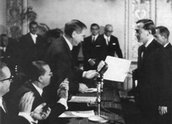
In the Head the Fire (1966)
Synopsis
Commissioned by the ABC, In The Head the Fire is a musical composition with words for radio. It is written for a speaker, vocal soloists, a choir, woodwind, brass and percussion instruments, a piano, an organ and a portative organ. It uses radiophonic techniques, which incorporate sound effects into music scores, and is written to dramatise action. It won the Prix Italia and is an important piece of Australian music.
Curator’s notes
This composition was written by the composer to be experienced only as recorded sound rather than as a live performance in a concert hall. It used radiophonic techniques, which emerged from experimentation with magnetic tape technology. The term ‘radiophonic’ originated from the French term ‘Musique Concrete’ or ‘Real Music’. Radiophonic describes a type of composition used in radio and television which incorporates sound effects into music scores, written to dramatise action.
Sonic artists such as Australia’s Jack Ellitt in the 1930s and Pierre Schaeffer in the 1940s, used reel-to-reel tape recorders to splice together acoustic sounds with spoken words in the compositional style which became known as Musique Concrete. In the early 1950s the Darmstadt Group in Germany used electronic keyboards and microphone-recorded sounds to alter sound frequencies, manipulate replay speeds, overlay audio tracks and incorporate reverberation and echo as compositional elements. These electronically derived compositions became known as Electroacoustic Music.
When Butterley was invited to compose this piece in 1966, he was working in the ABC Federal Music Department. ABC Federal Music Director John Hopkins offered Butterley the commission without any subject in mind but with a directive for the composer to fully exploit the musical and technical possibilities afforded by sound technology.
Soon after receiving the commission, a colleague working in the ABC Religious Department suggested a subject. Did Butterley know of the published text of the Dead Sea Scrolls, ‘The War of the Sons of Light and Darkness’ written between 200 BC and 68 AD? These texts became a starting point for Butterley’s piece. He used the notions of light and darkness and the symbolism contained within the Dead Sea Scrolls – the human struggle to find truth amid the forces of evil – for his basic subject matter. Butterley also drew upon the texts of an ancient Irish poem, a hymn of Saint Ambrose, the Latin Mass and verses from the Gospel of John, with passages in Hebrew, Latin and Greek. Using these texts, he structured the composition into seven sections.
1. Prologue – Irish Poem
2. Invocation – The Latin Mass
3. Prophecy – Dead Sea Scrolls
4. The War of the Sons of Light and Darkness – Dead Sea Scrolls
5. Thanksgiving – Dead Sea Scrolls
6. Sanctus – Choir recorded in distance: Latin Mass
7. Epilogue – Irish Poem
Butterley and conductor John Hopkins created layers of light and shade by recording the sound at close, middle and far distances. Butterley wrote the piece in an ‘arc’ form: the first two sections of the piece build, the central three sections culminate in a high crescendo of sound and music and the final two sections diminish in sound. The Dead Sea Scrolls, which comprise the three central and most heightened sections of the composition, are full of vivid images of battle.
The radiophonic techniques used in In The Head the Fire include:
- Reverberation – Persistence of sound in a space after the sound ceases to emanate from its source
- Multi-track recording
- Superimposing audio
- Re-recording reversed audio (clip one)
Radiophonic techniques became more commonly used in television in the early 1950s, and shows like Doctor Who (1963–current) in the early ’60s became known for distinctive sound effects, created by the BBC’s Radiophonic Workshop. Australian composer Ron Grainer collaborated with English composer Delia Derbyshire in the writing of the now iconic Doctor Who theme in 1963. Although most people wouldn’t have dreamt of listening to electroacoustic music in the 1950s, they were mesmerised by the sound effects and electronic scores written for these television shows.
Following the emergence of television, radio needed to reinvigorate its image and win back the audiences it had once commanded. Magnetic tape technology and radiophonic techniques gave radio the magic it needed to reinvent itself for a new generation of audiences. By winning the Prix Italia for In the Head the Fire Butterley helped put radio in Australia back on the map.
Broadcast in 1966 on ABC Radio, the work was intended to be Australia’s entry into the radio category of the prestigious international media competition the Prix Italia. It was established by Radiotelevisione Italiana to promote and award quality, innovation and creativity in radio and television programs and now web content. The composition was only the second Australian work to win the Prix Italia, following on from George Selwyn English’s 1959 winner, 'Death of a Wombat’.
- Overview
- Curator’s notes
- Audio 2 clips
- Principal credits
- Find a copy
- Make a comment
- Extras
- Add your review



